#dark energy
Text

#dark aesthetic#dark energy#asthetic#dark feminine energy#dark femininity#dark vibes#red and black#red and black aesthetic#dark feminine aesthetic#dark femenine#dark femme fatale#alt femme#dark femme#femme fatale life#femme empowerment#femme fatale vibes#dark feminine#femme fatale quotes#femme fatale
6K notes
·
View notes
Text

Astronomers used three of NASA's Great Observatories to capture this multiwavelength image showing galaxy cluster IDCS J1426.5+3508. It includes X-rays recorded by the Chandra X-ray Observatory in blue, visible light observed by the Hubble Space Telescope in green, and infrared light from the Spitzer Space Telescope in red. This rare galaxy cluster has important implications for understanding how these megastructures formed and evolved early in the universe.
How Astronomers Time Travel
Let’s add another item to your travel bucket list: the early universe! You don’t need the type of time machine you see in sci-fi movies, and you don’t have to worry about getting trapped in the past. You don’t even need to leave the comfort of your home! All you need is a powerful space-based telescope.
But let’s start small and work our way up to the farthest reaches of space. We’ll explain how it all works along the way.

This animation illustrates how fast light travels between Earth and the Moon. The farther light has to travel, the more noticeable its speed limit becomes.
The speed of light is superfast, but it isn’t infinite. It travels at about 186,000 miles (300 million meters) per second. That means that it takes time for the light from any object to reach our eyes. The farther it is, the more time it takes.
You can see nearby things basically in real time because the light travel time isn’t long enough to make a difference. Even if an object is 100 miles (161 kilometers) away, it takes just 0.0005 seconds for light to travel that far. But on astronomical scales, the effects become noticeable.
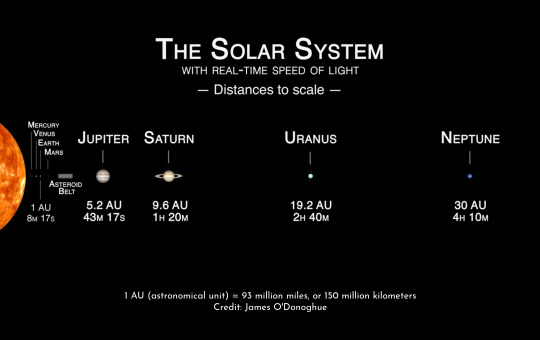
This infographic shows how long it takes light to travel to different planets in our solar system.
Within our solar system, light’s speed limit means it can take a while to communicate back and forth between spacecraft and ground stations on Earth. We see the Moon, Sun, and planets as they were slightly in the past, but it's not usually far enough back to be scientifically interesting.
As we peer farther out into our galaxy, we use light-years to talk about distances. Smaller units like miles or kilometers would be too overwhelming and we’d lose a sense of their meaning. One light-year – the distance light travels in a year – is nearly 6 trillion miles (9.5 trillion kilometers). And that’s just a tiny baby step into the cosmos.
youtube
The Sun’s closest neighboring star, Proxima Centauri, is 4.2 light-years away. That means we see it as it was about four years ago. Betelgeuse, a more distant (and more volatile) stellar neighbor, is around 700 light-years away. Because of light’s lag time, astronomers don’t know for sure whether this supergiant star is still there! It may have already blasted itself apart in a supernova explosion – but it probably has another 10,000 years or more to go.
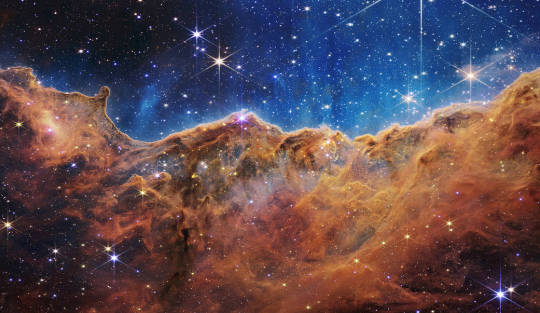
What looks much like craggy mountains on a moonlit evening is actually the edge of a nearby, young, star-forming region NGC 3324 in the Carina Nebula. Captured in infrared light by the Near-Infrared Camera (NIRCam) on NASA’s James Webb Space Telescope, this image reveals previously obscured areas of star birth.
The Carina Nebula clocks in at 7,500 light-years away, which means the light we receive from it today began its journey about 3,000 years before the pyramids of Giza in Egypt were built! Many new stars there have undoubtedly been born by now, but their light may not reach Earth for thousands of years.
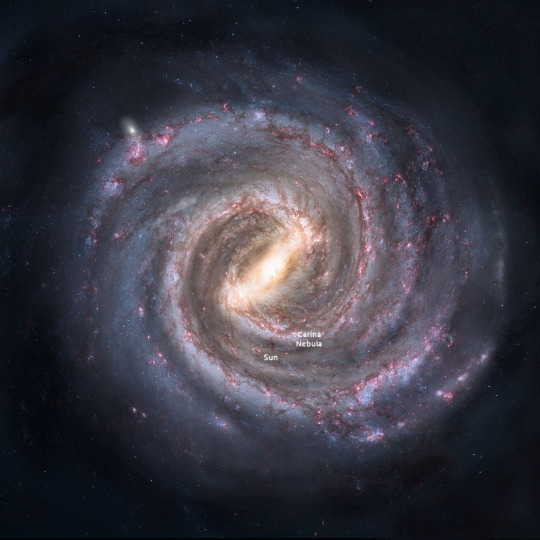
An artist’s concept of our Milky Way galaxy, with rough locations for the Sun and Carina nebula marked.
If we zoom way out, you can see that 7,500 light-years away is still pretty much within our neighborhood. Let’s look further back in time…

This stunning image by the NASA/ESA Hubble Space Telescope features the spiral galaxy NGC 5643. Looking this good isn’t easy; 30 different exposures, for a total of nine hours of observation time, together with Hubble’s high resolution and clarity, were needed to produce an image of such exquisite detail and beauty.
Peering outside our Milky Way galaxy transports us much further into the past. The Andromeda galaxy, our nearest large galactic neighbor, is about 2.5 million light-years away. And that’s still pretty close, as far as the universe goes. The image above shows the spiral galaxy NGC 5643, which is about 60 million light-years away! That means we see it as it was about 60 million years ago.
As telescopes look deeper into the universe, they capture snapshots in time from different cosmic eras. Astronomers can stitch those snapshots together to unravel things like galaxy evolution. The closest ones are more mature; we see them nearly as they truly are in the present day because their light doesn’t have to travel as far to reach us. We can’t rewind those galaxies (or our own), but we can get clues about how they likely developed. Looking at galaxies that are farther and farther away means seeing these star cities in ever earlier stages of development.
youtube
The farthest galaxies we can see are both old and young. They’re billions of years old now, and the light we receive from them is ancient since it took so long to traverse the cosmos. But since their light was emitted when the galaxies were young, it gives us a view of their infancy.

This animation is an artist’s concept of the big bang, with representations of the early universe and its expansion.
Comparing how fast objects at different distances are moving away opened up the biggest mystery in modern astronomy: cosmic acceleration. The universe was already expanding as a result of the big bang, but astronomers expected it to slow down over time. Instead, it’s speeding up!
The universe’s expansion makes it tricky to talk about the distances of the farthest objects. We often use lookback time, which is the amount of time it took for an object’s light to reach us. That’s simpler than using a literal distance, because an object that was 10 billion light-years away when it emitted the light we received from it would actually be more than 16 billion light-years away right now, due to the expansion of space. We can even see objects that are presently over 30 billion light-years from Earth, even though the universe is only about 14 billion years old.

This James Webb Space Telescope image shines with the light from galaxies that are more than 13.4 billion years old, dating back to less than 400 million years after the big bang.
Our James Webb Space Telescope has helped us time travel back more than 13.4 billion years, to when the universe was less than 400 million years old. When our Nancy Grace Roman Space Telescope launches in a few years, astronomers will pair its vast view of space with Webb’s zooming capabilities to study the early universe in better ways than ever before. And don’t worry – these telescopes will make plenty of pit stops along the way at other exciting cosmic destinations across space and time.
Learn more about the exciting science Roman will investigate on X and Facebook.
Make sure to follow us on Tumblr for your regular dose of space!
#NASA#astronomy#telescope#Roman Space Telescope#dark energy#galaxies#cosmology#astrophysics#stars#galaxy#Hubble#Webb#Chandra#Spitzer#space images#Youtube
3K notes
·
View notes
Text
Sweet dreams

#dark aesthetic#dark energy#witch aesthetics#witchcraft#dark academia#dark academia moodboard#witchy#nature aesthetic#witch#witchblr#bedroom#dark bedroom#witchy bedroom#magic
11K notes
·
View notes
Text

Hi my darlings, im back ! 🫶🏻
#wlw#wlw post#goth girl#dark energy#sapphic#sexy content#femme4all#send asks#anon ask#ask me anything#mommy's good girl#domme mommy#domme/sub
196 notes
·
View notes
Text
★。+゚☆゚+。★。+゚☆゚+。★。+゚☆゚+。★★。+゚☆




★。+゚☆゚+。★。+゚☆゚+。★。+゚☆゚+。★★。+゚☆
#girlblogger#coquette fashion#lana del rey aesthetic#angelcore#it girl#dollette#girl interrupted#lana del rey#lizzie grant#lily rose icons#00s#00s nostalgia#00s style#skins#skins gen 1#skins gen 2#effy stonem#dark energy#cassie skins#tony skins#sid jenkins#grunge coquette#carmen lana del rey
5K notes
·
View notes
Text

#meditation#mindfulness#spiritual awakening#spiritual music#spiritualgrowth#spiritual development#spiritualjourney#witch#witches#brujas#bruja#brujeria#dark energy#occult aesthetic#occultism#zen#100 days of self discipline#paganism
370 notes
·
View notes
Text
The universe is still expanding at an accelerating rate, but it may have slowed down recently compared to a few billion years ago, early results from the most precise measurement of its evolution yet suggested Thursday.
While the preliminary findings are far from confirmed, if they hold up it would further deepen the mystery of dark energy—and likely mean there is something important missing in our understanding of the cosmos.
These signals of our universe's changing speeds were spotted by the Dark Energy Spectroscopic Instrument (DESI), which is perched atop a telescope at the Kitt Peak National Observatory in the US state of Arizona.
Continue Reading.
128 notes
·
View notes
Text
Physics Friday: WTF is Dark Energy/Dark Matter? (Part 1)
To see what this is all about click here.
Preamble: Dark Numbers
Education level: High School (Y9/10)
Topic: Cosmology (Astronomy)
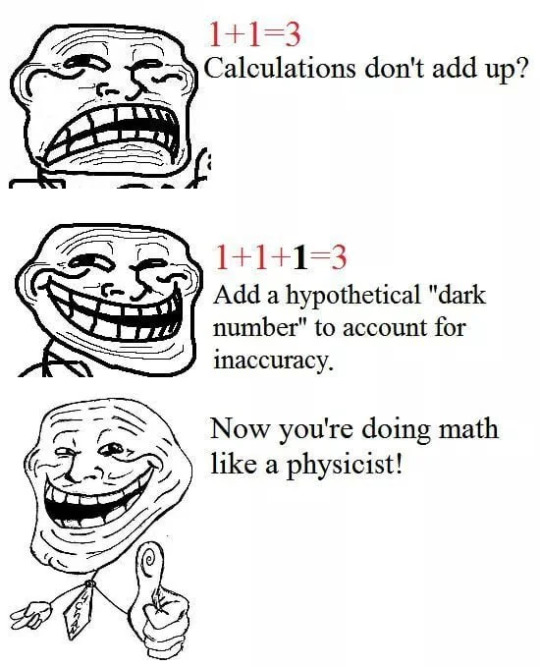
This equation is surprisingly the best representation of what we are doing with dark energy and dark matter. The equations we are using to figure out the nature of the universe are quite literally 'not adding up'.
When we have a situation where we encounter a missing number we are faced with three scenarioes:
Our model is wrong and we fucked up, physics is over
Our model works, but it's not complete. There are situations where it doesn't apply, and we are seeing an example of it
Our model is simply missing a few terms
Scenario 1 would imply that basic physics such as Newton's laws of motion and gravity are just plain wrong. Which is ... well ... a bit difficult to try and prove.
Scenario 2 implies that there is a more fundamental theory that underlies our current one. While it is not off the table, it can be difficult to find a theory for just one or two specific phenomena.
Scenario 3 is like 2, but it's a bit 'softer', what we're doing is just adding an extra number to balance out the equation and then trying to answer "What does this number mean"?
By Occam's razor, we can go with option 3, as it's simpler, and also appears to be more correct than a complete model change.
Dark Matter and Galaxies
Our galaxy is like the solar system in the sense that there is a large object in the centre surrounded by a bunch of stuff moving around that centre.
The difference between the two is the ratio between the central mass and the mass of the rest of the system.
If you combined all of the planets in the solar system together, it would still be less massive than the Sun.
This means we can easily calculate how the planets move around the Sun. As the motions of the other planets don't really affect that motion all too much. And thus we can use Kepler's 3rd Law:
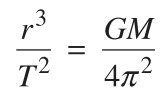
If you combined all of the stars in the galactic 'orb' surrounding the centre, you find that it would be much heavier than the black hole in the centre.
This means you have to account for a more spread out mass as you change your distance from the centre of the galaxy.
The further you are from the centre of the galaxy, the more stuff there is beneath you i.e. there's more stuff closer to the core than you. We have to calculate gravity taking this mass, and the radius to it, into account.
Thankfully, we have methods that can calculate this much easier. And we can use this to figure out our orbital velocity as a function of distance from the centre.
So let's try and calculate things! Take a galaxy, measure it's mass distribution independent of orbital mechanics, and find the orbital velocity!
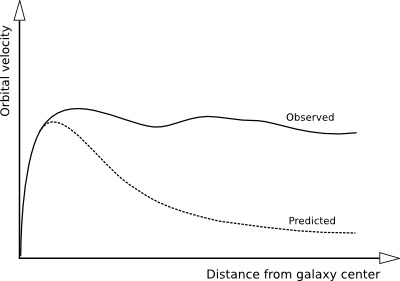
Image Credit: Citizendium
What we get is the graph above. In a normal universe, we expect our orbital velocity to increase near the core as more stuff gets added to the mass pulling us in. It then peters out as gravity looses it's strength.
What we actually see is that the orbital velocity takes a lot longer to peter out. If Newton's Laws/General Relativity are working how they should, this means that there must be a lot more mass in the galaxy.
What's worse is that this mass is much more evenly distributed. And not just that, but we cannot see it i.e. it does not interact with electromagnetic waves (light).
Hence we label this weird matter 'dark', because we can't see it and it helps us account for the disparity in the equation.
Next time I'll go into what we think dark matter actually is.
Dark Energy and Einstein's Blunder
General Relativity is one of the most backed-up theories in all of physics. The original conception of the theory comes from the Einstein Field Equations (EFEs):

We can safely ignore all of the fancy jargon symbols. What's important to us is what's missing.
When Einstein was playing around with his equations, he made an error. This error led him to missing a part in his equation. And thus he added an additional term to the EFEs:

This capital lambda term (Λ) helped balance his erronious equation.
Eventually, Einstein figured out that this was a mistake, a mistake so big that he called it his 'Biggest Blunder'. It turns out that the EFEs don't require Λ to actually work.
A few decades later, in the 1990s, researchers were trying to use the principles of general relativity to figure out the expansion of spacetime. Thanks to Edwin Hubble, we knew that space was expanding, but we didn't know how it was expanding.
The difficulty is that both the curvature and the amount of energy in the universe affected the expansion of the universe. This is dictated by the Friedmann equations:

Where the a's are the universe's scale factor, i.e. the current 'size' of the universe. The two p's are the mass and energy densities in the universe.
Using measurements of Type Ia Supernovae (you will see a topic on this in the future as I've done research into this), two teams of researchers were able to determine that the expansion rate of the universe was accelerating! Something completely unexpected.
This would require us adding an additional term to the equation involving our suspicious little friend:

This Λ variable, called the cosmological constant, can be propagated up the mathematical derivation chain to show that Einstein's 'mistake' was actually the correct equation all along!
The cosmological constant acts a energy density term that exists outside of our current understandings of the matter and energy in our universe. And because it's outside of our understanding, we call it 'dark' energy - because, just like dark matter, we can't see it.
It's a type of energy that isn't represented by any of the fundamental forces. What's more is that it is constant, which means as the universe expands, more gets added. And even more is that this energy density is negative, suggesting even that the universe is not a vaccum.
This discovery landed three researchers from both teams the Nobel prize in physics. One of the laureates includes the vice chancellor of my very own university, Brian Schmidt. Doxxing myself aside, this is a fact that neither me, nor my university, will shut up about.
In another part, I'll talk about what this dark energy could be and what an accelerating expansion of the universe could mean.
Conclusion
So despite the names, dark energy and dark matter are actually two different things that have two different sets of properties purposes (at least that's what we think). The names simply derive from the same method of using constants to help make our equations work better with reality.
It's always possible that we are wrong and there is a more fundamental equation that helps us understand these things. But that's a task for the future.
Hope you enjoyed reading and please give me feedback! I'm doing this every week as well, so feel free to follow if you want.
Next week I'll probably do something mathematics-related, before continuing on with this part.
#physics#astronomy#cosmology#dark matter#dark energy#physics friday#science#stem#academics#astrophysics
246 notes
·
View notes
Text
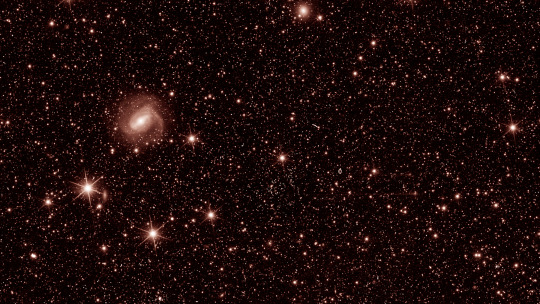
These are the first test views from Europe's new $1.4 billion space telescope. Euclid's purpose is to map out the dark side of our universe by analyzing billions of galaxies that reside up to approximately 10 billion light-years away.
Read more: https://rb.gy/mtire
#dark matter#dark energy#nasa#astronomy#astrophotography#solar system#astrophysics#hubble#physics#james webb images#james webb space technology#nebula#galaxies#guardians of the galaxy#europe
295 notes
·
View notes
Text
If you feel shame, fear or hesitance for displaying or learning about seductive behavior, you are not ready yet. Seduction is not a game for nice or moralistic people. Seduction is for people who have become one with their shadow selves and know how to wield their true power.
Seduction isn't evil..It's the higher way of life - S.S.
#succulentsiren#dark feminine energy#seduction#patreon#writers and poets#divine feminine#dark energy#darkness#witch#witchcraft#craft#dark femininity#siren#goddess#magic#the art of seduction#tactics#intelligence#seduction series#affirmations#femininity#it girl#morals#morality#beliefs
69 notes
·
View notes
Text
WHAT IS THE INFORMATION PARADOX??
Blog#355
Wednesday, December 6th, 2023
Welcome back,
Afew years ago a team of chemists unboiled an egg. Boiling causes protein molecules in the egg to twist around one another, and a centrifuge can disentangle them to restore the original. The technique is of dubious utility in a kitchen, but it neatly demonstrates the reversibility of physics. Anything in the physical world can run both ways—it's one of the deepest features of the laws of physics, reflecting elemental symmetries of space, time and causality.

If you send all the parts of a system into reverse, what was done will be undone. The information required to wind back the clock is always preserved. Of course, undoing a process may be easy in simple systems but is less so in complex ones, which is why the egg unboiler was so nifty.
But there's a troubling exception: black holes. If a massive enough star collapses under its own weight, its gravity intensifies without limit and locks matter in its grip. Jump into one, and there's no going back. Merge two together, and you can't split them apart.

A black hole presents an almost completely featureless façade to the universe. Looking at it, you can't tell what fell in. The black hole does not seem to preserve information. This irreversibility, first appreciated by physicist David Finkelstein in 1958, was the earliest inkling of the black hole information paradox—“paradox” because how could reversible laws have irreversible effects? The paradox signaled a deeper disease in physicists' understanding of the world.

Scientists have many reasons to seek a grand unified theory of nature, but the information paradox is their most specific motivation, and it has guided their way when they have little else to go on.
At last, more than 60 years after this puzzle began to appear, physicists are seeing hope for a solution. In the year leading up to the pandemic and through the months of lockdown, a coalition of theorists took huge strides to understand the paradox—the most progress in decades, some say.

They bolstered the idea that black holes, despite appearances, are reversible, and they dissolved the official paradox. Physical theory is no longer at odds with itself. The work is contentious, though, and by its proponents' own admission, it is at best a starting point for a full explanation of black holes.
Until recently, most of the “progress” physicists have made on this paradox over the decades has consisted of realizing the problem is even harder than they'd thought. Finkelstein's original work left loopholes.
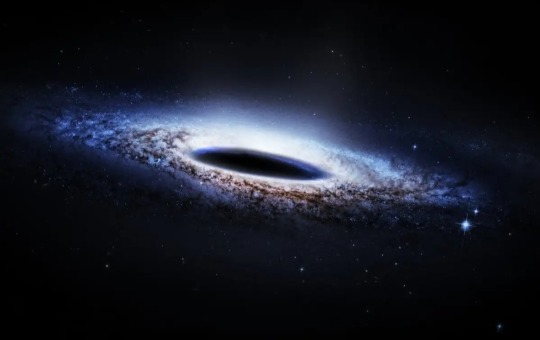
For one, it was based on Einstein's general theory of relativity, which physicists knew was not the full story, because it left out quantum effects. In the 1970s Stephen Hawking—in the work that made him a household name—took a first crack at including those effects. His calculations predicted that black holes slowly release energy. But this emission carries no information about whatever had fallen in, so it doesn't help wind back the clock.

If anything, the outgoing trickle of particles worsens the predicament. The black hole eventually empties itself of energy and evaporates away like a puddle on a summer's day. All the matter it imprisoned is not freed but wiped out of existence. Hawking's analysis elevated a general unease into a full-fledged crisis for physics.
Originally published on www.scientificamerican.com
COMING UP!!
(Saturday, December 9th, 2023)
"WHAT ARE WHITE DWARFS??"
#astronomy#outer space#alternate universe#astrophysics#universe#spacecraft#white universe#space#parallel universe#astrophotography#black holes#blackholes#dark energy
119 notes
·
View notes
Text

#dark energy#dark aesthetic#dark feminine energy#dark femininity#dark vibes#asthetic#red and black aesthetic#red and black#dark feminine#dark feminine aesthetic
803 notes
·
View notes
Text
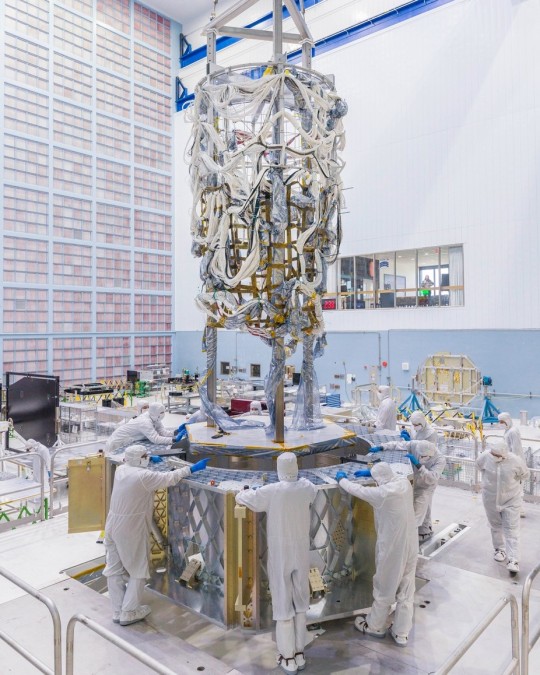
The Nancy Grace Roman Space Telescope’s flight harness is transferred from the mock-up structure to the spacecraft flight structure.
Your Body is Wired Like a NASA Space Telescope. Sort Of.
If our Nancy Grace Roman Space Telescope were alive, its nervous system would be the intricate wiring, or “harness,” that helps different parts of the observatory communicate with one another. Just like the human body sends information through nerves to function, Roman will send commands through this special harness to help achieve its mission: answering longstanding questions about dark energy, dark matter, and exoplanets, among other mind-bending cosmic queries.
Roman’s harness weighs around 1,000 pounds and is made of about 32,000 wires and 900 connectors. If those parts were laid out end-to-end, they would be 45 miles long from start to finish. Coincidentally, the human body’s nerves would span the same distance if lined up. That’s far enough to reach nearly three-fourths of the way to space, twice as far as a marathon, or eight times taller than Mount Everest!

An aerial view of the harness technicians working to secure Roman’s harness to the spacecraft flight structure.
Over a span of two years, 11 technicians spent time at the workbench and perched on ladders, cutting wire to length, carefully cleaning each component, and repeatedly connecting everything together.
Space is usually freezing cold, but spacecraft that are in direct sunlight can get incredibly hot. Roman’s harness went through the Space Environment Simulator – a massive thermal vacuum chamber – to expose the components to the temperatures they’ll experience in space. Technicians “baked” vapors out of the harness to make sure they won’t cause problems later in orbit.

Technicians work to secure Roman’s harness to the interior of the spacecraft flight structure. They are standing in the portion of the spacecraft bus where the propellant tanks will be mounted.
The next step is for engineers to weave the harness through the flight structure in Goddard’s big clean room, a space almost perfectly free of dust and other particles. This process will be ongoing until most of the spacecraft components are assembled. The Roman Space Telescope is set to launch by May 2027.
Learn more about the exciting science this mission will investigate on X and Facebook.
Make sure to follow us on Tumblr for your regular dose of space!
#NASA#astronomy#telescope#Roman Space Telescope#engineering#space hardware#dark energy#dark matter#space#technology#tech#universe
4K notes
·
View notes
Text

Mi casa su casa
#dark aesthetic#dark energy#witch aesthetics#witchcraft#witchy#dark academia#dark academia moodboard#nature aesthetic#witch#witchblr#whimsigoth
4K notes
·
View notes
Text

Have a good night baby ! ✨
#wlw#dark energy#goth girl#wlw post#sexy content#femme4all#mommy issues#mommy's good girl#mommy's girl
215 notes
·
View notes



